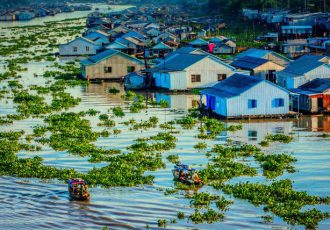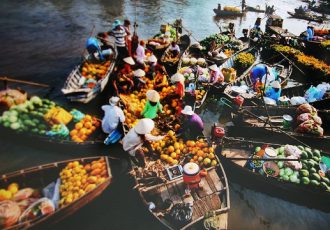The Mekong Delta is Vietnam’s largest rice bowl! The area is crossed by the Mekong which is the 12th longest river in the world and the seventh longest in Asia. It crosses six countries in total (China, Laos, Myanmar, Thailand, Cambodia and Vietnam). The Vietnamese call it the River of Nine Dragons (Song Cuu Long) because of the river’s separation into nine arms.

Summary
The landscapes of the Mekong Delta
The most fertile soil in Vietnam is a large land formed by alluvium and sediment deposited by the river. It offers unique landscapes. It is a half-terrestrial, half-aquatic world, crisscrossed by a multitude of green canals, rice fields and fruit gardens, islands and villagers that live to the rhythm of the river and the sea.
In this naturally rich and prosperous delta, water and rice are the basis of the local economy. The nine provinces that make it up to represent 12% of the total area of Vietnam, but provide a large part of the country’s food production each year. With two annual rice harvests, the country now exports its rice, it would be the 2nd largest exporter in the world, just after Thailand.
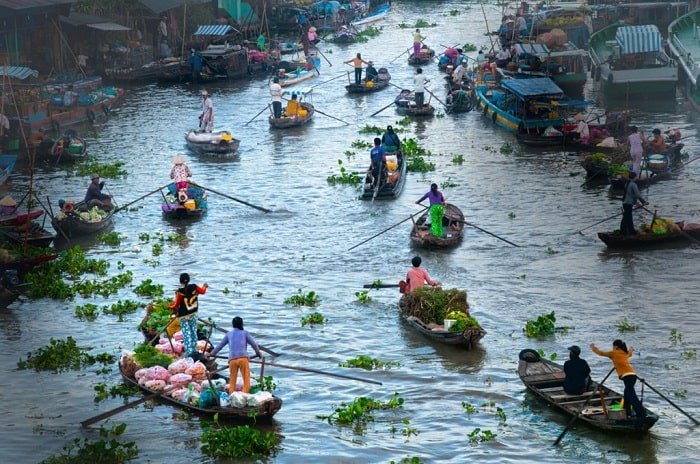
The rice fields describe a checkerboard shimmering to infinity. The landscapes of the delta have been shaped by the waters. They owe him a lot. Nothing happens without the river. Agricultural work, fishing, transport, traditions, pleasures, the least thing depends on the Mekong. Here, people prefer to slide on the water than to ride motorbikes or bicycles.
Fauna and flora
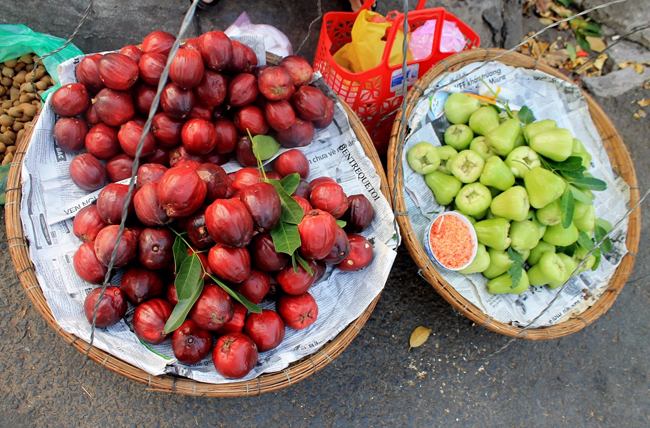
Many animals live in the Mekong Delta. The river gives great fertility to this land and has made it a kingdom for birds, crocodiles, and all kinds of animals. There is incredible biodiversity.
This region of the country is the main supplier of tropical fruits (70%) and is also the main producer and exporter of rice (60%) in the country.
Where is the Mekong Delta located?
At the southern end of the country, between the agglomeration of Ho Chi Minh City, the Cambodian border, the China Sea and the Gulf of Siam, extend an immense and low plain, the Mekong Delta, extremely fertile, crossed by the nine branches of a river bursting into pieces (Cu Long in Vietnamese, which means “nine dragons”) which flows into the tropical sea.
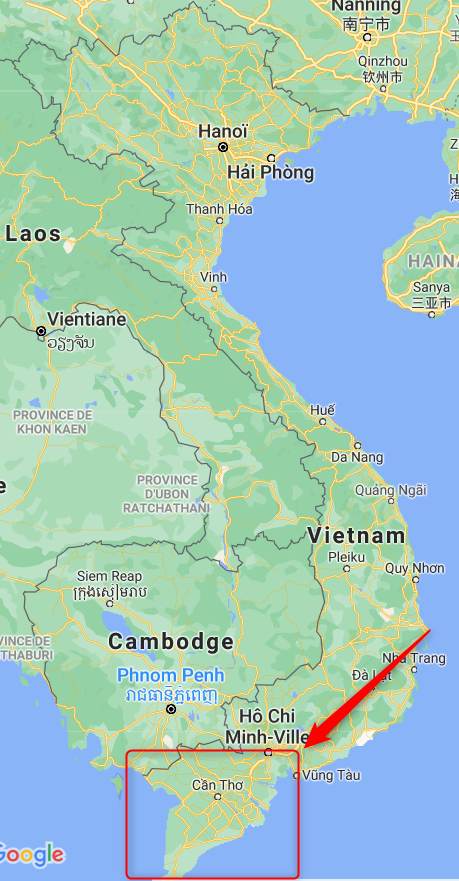
What to see in the Mekong Delta?
There are names of places that are like known music, encountered… engraved in our memories… The Mekong Delta is undoubtedly one of them. We “recognize” it. So rather than “seeing” things here, we walk and experience a way of life, an area of the world with an original rhythm and habits.
Indeed, traveling is not only about the places you go, but also about the people you meet and the cultures you discover.
Discovering the people of the delta
Visiting the Mekong Delta means you are giving yourself a chance to experience the authentic life of the locals who depend on the river for their livelihood. The people on this earth are special, armed with serenity in keeping with their natural surroundings. They are very friendly and won’t hesitate to help you or even welcome you into their home for lunch or a night out – all without asking for anything in return. They’re not competitive – they’re happy with the life they lead even if it’s not that simple.
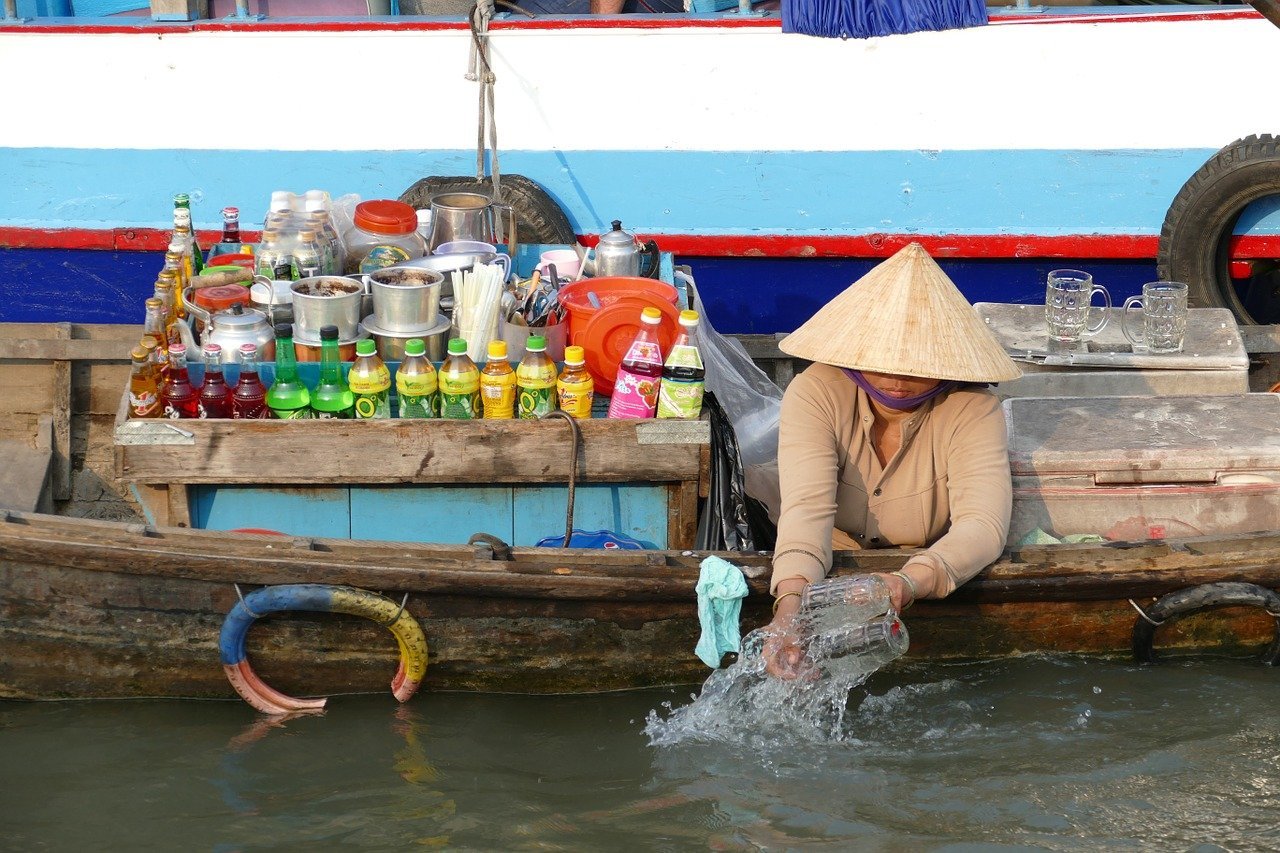
The Mekong Delta will welcome you with calm and escape from the cars, the noise of traffic and the incessant honking of motorbikes that you find in our big cities.
Here are the main places to discover in the Delta that allow a soft and warm immersion!
My tho and its surroundings
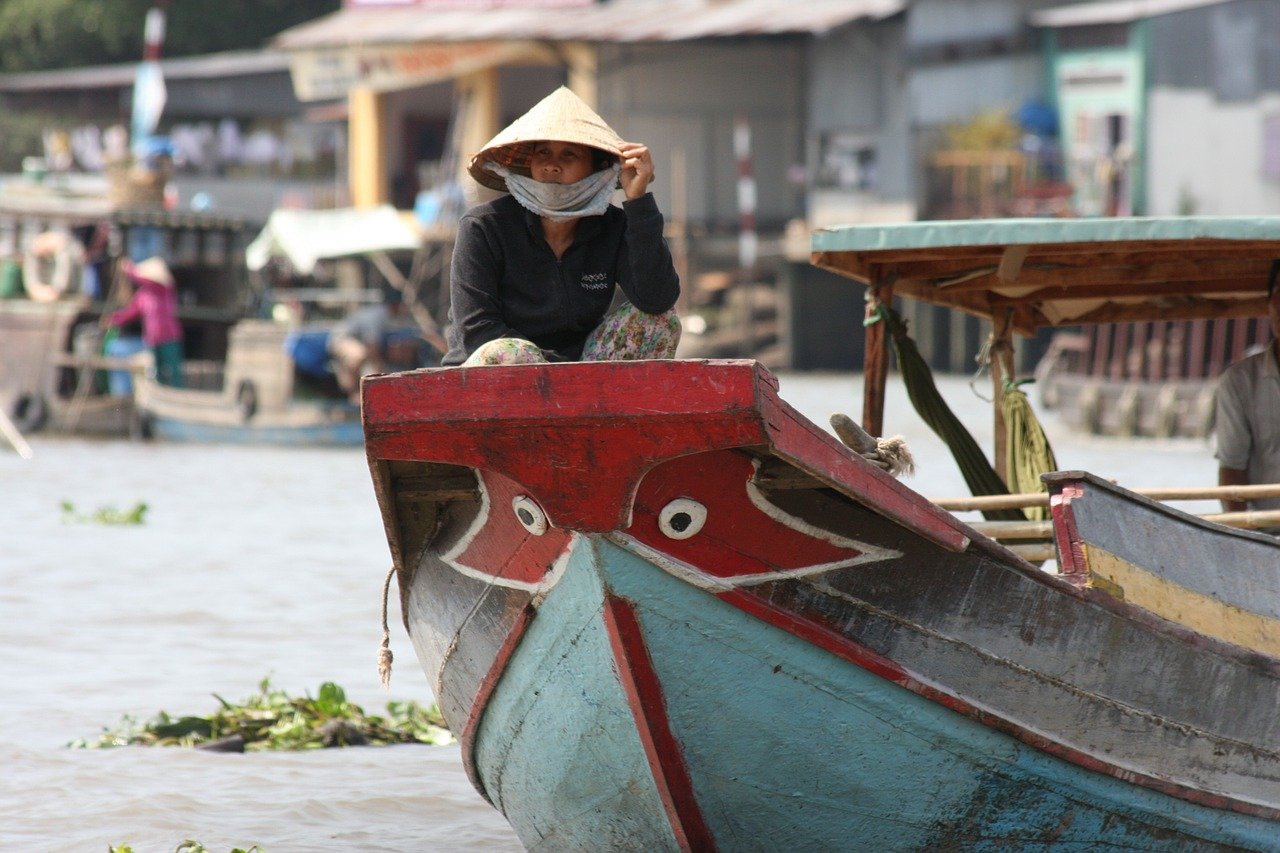
Of Khmer origin, My Tho became Vietnamese in the 17th century. Located 2 hours from Ho-Chi-Minh, the city has 200,000 inhabitants. They live from the production of rice, fruit and fishing. People mainly come to My Tho because it is the starting point for boat trips on the Mekong to visit the surrounding islands in one day.
My tho is located in the province of Tiên Giang. The area now has about 1.7 million inhabitants belonging to the Kinh, Hoa (Chinese), Khmer and Tây ethnic groups.
The region is known for its large expanses of rice fields as well as huge orchards and other plantations of exotic fruits. It provides rice, but above all fruit: bananas, mangoes, longans, plums, soursop, guavas…
My Tho offers a great insight into life in the Mekong Delta.
Ben Tre
Known by the Vietnamese as the “land of coconuts”, Ben Tre is one of the best places to explore the natural and untouched landscapes of the Mekong Delta. We discover its local life, its magnificent canals and its traditional activities. An authentic and relaxing experience!
Ben Tre is located 14 km from My tho and 90 from Saigon. You can choose to travel the canals by boat. Board a small boat to visit typical workplaces. Including small brick factories and a coconut processing workshop.
You can also consider a bike ride to explore the fields along the scenic canals.
Vinh long
Vinh Long is a province located in the Mekong Delta in southern Vietnam. Its capital bears the same name: Vinh Long. Its population is 1 million and its area is 1,475 km2.
Vinh Long is located about 135 km southwest of Saigon, Situated between the Hau and Tien rivers in the center of the Mekong Delta, Vinh Long is a province well known for fishing.
Basa and Tra shrimp and catfish are among the many types of fish. They exist in abundance in the waters of Vinh Long. Its rich and fertile soil makes Vinh Long an ideal place for growing many exotic and delicious fruits. Like the weird-looking mangosteen, the prickly rambutan, and the pungent-scented durian. These fruits can be purchased for pennies from floating merchants.
Can Tho – Capital of the Mekong Delta

Especially after a few calm days in the delta, Can Tho gives the effect of a big metropolis. Can Tho is a bustling city with a cheerful waterfront, many winding alleys, wide boulevards, and lots of industry. It is also the starting point for those who want to visit the floating markets of the region and who wish to explore small canals leading out of town with a sampan.
A highlight of the Mekong Delta: the floating market of Can Tho.
Cai Rang floating market, one of the largest in the Mekong Delta, just a few kilometers from the city center. The best way to explore the market with its overflowing abundance of fruits and vegetables is early in the morning by boat.
Phong Dien Floating Market is located a little further from Can Tho. It is slightly smaller. This market is visited by few tourists and is, therefore, more authentic
Chau Doc
Chau Doc (Vietnamese: Châu Đốc) is a small town in An Giang Province, in the Mekong Delta region of Vietnam, bordering Cambodia. The city is located near the Hâu River (a branch of the Mekong River crossing Vietnamese territory) and the Vinh Tê Canal. The city is 250 kilometers west of Ho Chi Minh City.
It is the homeland mainly of the Cham and Khmer people therefore the cultural diversity of Chau Doc, akin to the nearby mosques, temples, churches, and pilgrimage sites makes it fascinating to explore. you will have the opportunity to experience Cambodian culture without going to the country.
Taking a boat trip to the Cham communities across the river or heading to nearby Sam Mountain and the Tra Su Bird Sanctuary are some of the area’s highlights, while the bustling market and the waterfront provide beautiful backdrops to a few days of relaxation.
Floating houses in the Mekong delta

In the whole of the Mekong Delta, you will see particular dwellings in height. Local residents have adapted to a large amount of water by innovating floating houses and floating markets. Due to this floating lifestyle, the Mekong Delta in Vietnam has intrigued not only foreigners but also local travelers who wish to explore this interesting way of life.
When to go to the Mekong Delta?
The subtropical climate of the Mekong Delta makes it possible to consider a discovery at any time of the year. Here is the information about the climate of the Mekong Delta for you to make your choice.
The period of good weather which extends from December to May is conducive to travel, bike rides are pleasant.
The rainy season begins in early May and until October. Precipitation is generally heavy and transient. they clean the atmosphere and nature is cleaner and less dusty.
This period is called “mùa nước nỗi” which means rising water season: we travel by boat in the countryside, and the aquatic fauna will spread everywhere, source of food for the population.
The Mekong Delta is also a region producing flower plants, in September and October, flowers adorn the plantations as in the region of Mỹ Tho and Sa Déc.
The average annual temperature ranges from 23 to 34 degrees.
Video floating market
Watch our floating market video
Did you know that the city of Jinan in the province of Shandong in China is also a city of water!

